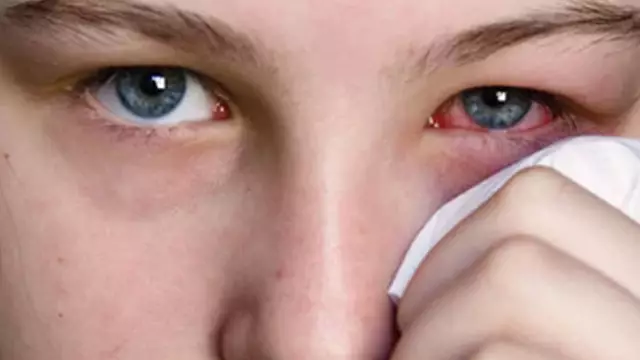- Author Rachel Wainwright [email protected].
- Public 2023-12-15 07:39.
- Last modified 2025-11-02 20:14.
Bacterial conjunctivitis
The content of the article:
- Causes and risk factors
- Forms of the disease
- Bacterial conjunctivitis symptoms
- Features of the course of bacterial conjunctivitis in children
- Diagnostics
- Treating bacterial conjunctivitis
- Possible complications and consequences
- Forecast
- Prevention
Bacterial conjunctivitis is an infectious disease caused by a bacterial infection that affects the lining of the eye.

Abundant mucopurulent discharge from the conjunctival sac is a sign of bacterial conjunctivitis
In the general structure of ophthalmic diseases, conjunctivitis accounts for 30%, with 73% being bacterial conjunctivitis. The incidence of acute bacterial conjunctivitis has a seasonal dependence, increasing in the autumn-winter period. The acute form of bacterial conjunctivitis is often combined with keratitis (inflammation of the cornea of the eye) and blepharitis (inflammation of the eyelid). Acute bacterial conjunctivitis in children is one of the most common infectious diseases, to which children 2-7 years old are most susceptible. In children under 4 years of age, conjunctivitis accounts for approximately 30% of all cases of ophthalmic pathology.
Causes and risk factors
Normally, bacteria of the conditionally pathogenic group (staphylococci, propionibacteria, etc.) are present on the surface of the conjunctiva and the edges of the eyelids, which do not cause inflammation. The resistance of the conjunctiva of the eye to infections is provided, first of all, by the antibacterial action of the lacrimal fluid, which contains protective factors. Blinking movements of the eyelids contribute to the mechanical removal of microorganisms from the surface of the eye.
The development of an acute form of bacterial conjunctivitis is facilitated by the weakening of general and local immunity, the ingress of a foreign body into the eye, mechanical damage to the conjunctiva, past infectious diseases, stress, hypothermia. In addition, the risk of developing the disease increases with dry eye syndrome, damage to the lacrimal duct and some other pathologies of the organ of vision.
Infectious agents in bacterial conjunctivitis can be both opportunistic and pathogenic microorganisms: staphylococci, streptococci, pneumococci, gonococci, intestinal, hemophilic and Pseudomonas aeruginosa, Proteus, corynebacterium diphtheria. The pathogen is transmitted through contaminated hands, household items (towels, bed linen, toys), water. Infection can occur in closed water bodies, swimming pools. Increase the risk of developing bacterial conjunctivitis by violating the recommendations for the use of contact lenses. In the appearance of bacterial conjunctivitis, climatic conditions of residence, as well as the level of everyday culture, are of no small importance.

Various infectious agents lead to the development of bacterial conjunctivitis
Acute bacterial conjunctivitis in newborns develops during intrauterine infection or during childbirth if the woman in labor has infectious and inflammatory diseases of the urinary tract. Prematurity contributes to the emergence of this and other infectious pathologies.
Forms of the disease
Bacterial conjunctivitis can be acute or chronic.
Depending on the type of infectious agent that caused the inflammatory process, staphylococcal, streptococcal, pneumococcal, diphtheria, etc. conjunctivitis is isolated.
Bacterial conjunctivitis symptoms
Acute bacterial conjunctivitis develops quickly, from the moment of infection to the onset of clinical manifestations of the disease, it takes from several hours to several days.
Bacterial conjunctivitis symptoms:
- infiltration of the conjunctiva;
- hyperemia of the conjunctiva;
- swelling of the conjunctiva;
- pinpoint hemorrhages;
- pain, itching and burning in the eye;
- feeling of the presence of a foreign body;
- copious mucopurulent discharge from the conjunctival sac, which, when dry, can stick the eyelashes and form crusts at the edges of the eyelids.

This is what bacterial conjunctivitis looks like.
With significant swelling, the patient may experience an infringement of the conjunctiva in the palpebral fissure when the eyelids are closed. Usually, eye damage in bacterial conjunctivitis is initially unilateral, then the second eye is also involved in the pathological process, but sometimes the inflammation is immediately bilateral. In some cases, patients also complain of a deterioration in general well-being (an increase in body temperature to subfebrile values, headache, insomnia, a feeling of weakness), damage to the respiratory tract. The duration of the acute form of bacterial conjunctivitis is 1-2 weeks.
Chronic bacterial conjunctivitis develops gradually, this form of the disease is characterized by a persistent long course. The clinical picture is scanty - there is a slight hyperemia of the eyelids, the patient is worried about discomfort and mild discomfort in the eyes (feeling of dryness, burning, itching).
Features of the course of bacterial conjunctivitis in children
Bacterial conjunctivitis in children is often complicated by the addition of keratoconjunctivitis and blepharitis. Also, extraocular manifestations of the infectious process (otitis media, pharyngitis, vulvovaginitis, pneumonia, etc.) are often observed.

In children, bacterial conjunctivitis is often complicated by blepharitis and keratoconjunctivitis.
Clinical manifestations of conjunctivitis of gonorrheal etiology in newborns usually occur on the 2-3rd day after birth. As a rule, the lesion is bilateral. The child has a dense swelling of the eyelids, a cyanotic-purple tint of the skin, hyperemia and infiltration of the conjunctiva, abundant serous-hemorrhagic, and then purulent discharge from the conjunctival sac. Gonococcal conjunctivitis in newborns can lead to the development of ulcers and infiltrates of the cornea of the eye, the formation of a leucorrhoea, decreased visual acuity or blindness, the development of endophthalmitis (purulent inflammation of the inner membranes of the eyeball) or panophthalmitis (purulent inflammation of all structures of the eye).
Diagnostics
Diagnosis of bacterial conjunctivitis is carried out by an ophthalmologist on the basis of the clinical picture, as well as the results of an objective examination. To identify an infectious agent, they resort to microscopic and bacteriological examination of a smear from the conjunctiva with an antibiogram. In order to detect hyperemia and looseness of the conjunctiva, as well as defects of the cornea and vascular injection, the structures of the eye are examined using a slit lamp (biomicroscopy).
To differentiate bacterial conjunctivitis with ulcerative lesions of the cornea, a fluorescein instillation test is performed.
Treating bacterial conjunctivitis
To avoid the spread of infection, the patient is isolated from the team, this is especially important for bacterial conjunctivitis in children attending preschool and school institutions. Hospitalization is not required.
The main treatment for acute bacterial conjunctivitis is the local use of antibacterial drugs, the choice of which is based on the results of the antibiogram. In addition, a thorough treatment of the eyes with an antiseptic is carried out (jet washing of the conjunctival sac and wiping the eyelids with an antiseptic solution). Each eye is treated with separate cotton swabs from the outer edge to the inner edge. Even if only one eye is inflamed, both are treated. After that, instillation of antibacterial eye drops is carried out at intervals of 2-3 hours. At night, an antibacterial ointment is placed behind the eyelids. In the case of severe edema and inflammatory changes in the conjunctiva of the eye, anti-inflammatory drops are prescribed.

Antibacterial drops or ointments are prescribed to treat bacterial conjunctivitis
In the acute form of bacterial conjunctivitis, it is not recommended to apply a blindfold over the eyes, since this prevents the evacuation of pathological contents from the conjunctival sac and increases the risk of involvement in the infectious-inflammatory process of the cornea.
The treatment regimen for chronic bacterial conjunctivitis is similar to that in the acute form of the disease, but the treatment may be longer.
It is important not to stop the treatment of bacterial conjunctivitis immediately after the disappearance of the clinical manifestations of the disease, but to complete the course. Otherwise, there is a risk of developing resistance of microorganisms to antibacterial agents, as well as the occurrence of relapses and complications. After completing the treatment of bacterial conjunctivitis, it is recommended to conduct a bacteriological examination of the contents of the conjunctival cavity.
Possible complications and consequences
Against the background of bacterial conjunctivitis, inflammatory diseases of the eyelids, scarring of the conjunctiva of the eye, ulceration or perforation of the cornea, hypopyon (pathological accumulation of purulent exudate in the lower parts of the anterior chamber of the eye), decreased visual acuity, sepsis, meningitis can develop.
Forecast
Timely detection and adequate treatment of bacterial conjunctivitis allows for a cure without adverse effects on visual function. With the repeated development of the pathological process, there is a risk of reduced visual acuity.
Prevention
In order to prevent bacterial conjunctivitis, it is recommended:
- compliance with the rules of personal hygiene;
- proper care of contact lenses;
- prevention of eye injury;
- timely treatment of infectious processes of the nasopharynx and skin.
For the prevention of bacterial conjunctivitis of newborns, it is necessary to diagnose and treat urogenital infectious diseases in pregnant women, carry out preventive treatment of the eyes of children after birth, and also carefully handle newborn care items.
YouTube video related to the article:

Anna Aksenova Medical journalist About the author
Education: 2004-2007 "First Kiev Medical College" specialty "Laboratory Diagnostics".
The information is generalized and provided for informational purposes only. At the first sign of illness, see your doctor. Self-medication is hazardous to health!






